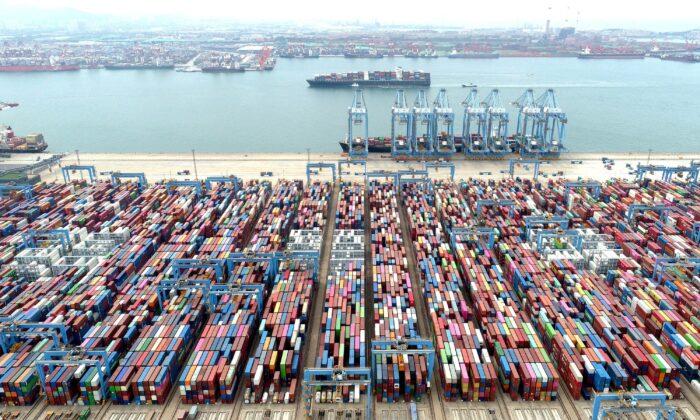Container production is waning in China, where empty containers collect in ports amid weakening exports. All these are indicators that China’s shipping industry is in a state of decline.
Data shows that the global production of new containers in the first quarter of 2023 has fallen to the lowest since 2010.
Drewry expects continued weakness in shipping trade in 2023, with the global container fleet contracting by 2 percent, which would be the first capacity decline in 14 years.
Sales, Net Profit Plunge
According to a report released by the U.S. Federal Maritime Commission in March 2022, China’s China International Marine Containers (CIMC), DongFang International Container, and CXIC Group Company produced 82 percent of the world’s containers.The China Container Industry Association puts it even higher with Chinese companies, led by CIMC, producing 95 percent of the world’s containers.

In 2021, the demand for shipping soared due to the impact of COVID-19. The cumulative sales volume of dry cargo containers of CIMC reached 2.5113 million TEU that year, an increase of 1.5 times over the sales volume in 2020. Revenue from the group’s container business nearly tripled year-on-year.
However, starting in 2022, with the end of the pandemic in most parts of the world, the landscape of the maritime market changed. With weak demand, freight rates continued to decline, driving the cumulative sales of dry cargo containers of CIMC in 2022 to drop sharply to 1.1073 million TEU, down nearly 56 percent year-on-year. Revenues at the group’s container business fell almost 31 percent year on year.
Entering the first quarter of 2023, the decline in container sales of CIMC continued. Among them, the cumulative sales volume of standard dry cargo containers was 82,500 TEU, down about 76.69 percent year-on-year. The cumulative sales volume of coolers was 12,100 TEU, down about 62.54 percent year-on-year. The cumulative sales volume of special dry cargo containers was 66,100 units, down 13.37 percent year-on-year.
Containers Collect in Ports
The sharp decline in container production has coincided with a worsening of container accumulation at Chinese ports.At Shanghai Port, the CAx index for 40-foot containers was above 0.5 in all but two weeks of 2022, mostly between 0.55 and 0.6. Since the beginning of 2023, the piling of 40-foot containers has intensified, with the CAx index all above 0.63. The CAx index of 20-foot containers was above 0.53 in 2022, and the index in 2023 is all above 0.65. The figures show that the number of containers entering the port is far greater than the number of containers leaving the port.

Weak Exports
According to data released by China’s National Bureau of Statistics at the end of May, the new export orders index of China’s manufacturing industry, which reflects the prosperity of the country’s export trade, fell again below the 50 percent threshold in April to 47.6 percent. In May, the index fell further to 47.2 percent, indicating continued weakness in export trade.The lack of export orders in the manufacturing industry has made the demand for export shipping weak, and shipping prices have continued to fall.
China Containerized Freight Index (CCFI) compiled by Shanghai Shipping Exchange is calculated by the freight rate and container volume of 12 representative routes, reflecting the trend of container shipping prices exported from Chinese ports, as well as the global trade supply and demand situation.
After that, the indexes fell sharply.
As of June 2, the freight indexes to the West Coast, East Coast, and Europe fell to 699.5, 860, and 1,150, respectively. Compared with the high point in February 2022, they shrank by 74, 69, and 80 percent, falling to levels before COVID-19.

For the subsequent trend of the container shipping market in 2023, COSCO believes that due to geopolitical tensions, high inflation, tight monetary policy in European and American countries, and other factors, the container shipping industry demand will further slow down. Coupled with changes in the trade pattern, industry competition will further intensify.





